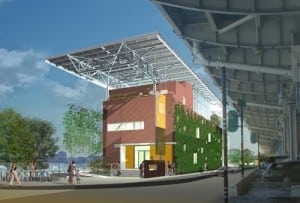Buildings that produce as much energy as they consume, net-zero energy, tend to hum cleanly along out in the boonies. They are usually private homes that are off the grid, or buildings that produce power and sell it back to the grid. The closest most of us get to these buildings is on the pages of Architectural Digest.
But now, Solar One, a clean-energy-powered arts and education center, is upgrading its digs in Manhattan to net-zero.
“It’s important in a city like New York to have a building like this, because so much of our carbon dioxide emissions come from buildings,” Chris Collins, Solar One’s executive director, told Engineering for Change. ”This could be the standard for building in the future.”
The new carbon-neutral building is called Solar Two. Collins expects to begin construction next year. The retrofit has a $10-million-plus price tag, and Solar One is still raising the last half of the money needed to begin. In the meantime, the finished blueprints show a graceful design loaded with the latest in clean technology. Here’s a short list of what to expect:
Site
The building’s design is a convergence of technology with the natural world, and that’s even reflected in its site: it’s sandwiched between highrises and a river. The traffic-snarled FDR Drive flanks it, and the East River faces it, with water views from its solar-powered stage, eco-cafe, and wetlands exhibit.
Sun
Solar2’s rooftop solar panel array will supply all of the building’s power. That’s 99,000 Kwh per year, enough for every function in the energy-stingy building. The twist is that the designers planned for obsolescence—the panels won’t be integrated into the roof, so swapping them out for an upgrade will be easier.
Besides electricity, the building will draw heat and light from the sun with strategic window placements. And a solar water heater will supply hot water.
Air
The ventilation system will run on two natural power sources: wind and temperature. Vents will take advantage of the wind off the East River and the stack effect. Stack-driven ventilation allows air to move from warmer regions to cooler ones. For example, if the building’s interior is warmer than the outside air, the air indoors rises up and out, which lowers the pressure forcing and pullsing cooler outside airto stream in through ground-level vents.
Water
A rooftop garden will help regulate the temperature. Green roofs create microclimates that keep buildings cooler in the summer, and they insulate the building in the winter to help retain heat that would otherwise escape through the ceiling..
Rain and the building’s own recycled water will keep the garden green. Rainwater collectors will channel the water into a tank for irrigation. And a blackwater treatment system will recycle wastewater for use in toilets and in some garden irrigation. Toilets will be low-flow and urinals water free.
Earth
Okay, this category should share the credit with water, but the subheading remains for dramatic effect. A geothermal system of underground water will heat and cool the building. Closed condenser loops will descend through 18 vertical shafts, each 495 feet deep. At that depth, the ground naturally regulates the temperature. It keeps the water above 45° F in the winter and below 75° F in the summer. Heat pumps will transfer heat to and from the loops to the air. Two loops are already installed, part of the preliminary research in the design phase.
“With buildings continuously striving towards lower overall energy consumption, I do foresee a rising demand for this type of system,” said Camille Bowman, senior mechanical engineer at Arup, the firm working on Solar Two.
This won’t be the first time that Arup has built such green tech into a building. The firm built geothermal systems at the Kresge Foundation Headquarters in Troy, Michigan and at the Syracuse Center of Excellence in Syracuse, New York. The difference at Solar Two is that by combining all of its design tricks, Arup could create the first urban net-zero energy building.
Education
All of Solar2’s green systems will be behind glass as a kind of clean-tech display case. Part of everything that makes it work will be exposed. Students, design geeks and regular passersby will be able to inspect the systems any time. In fact, that’s part of the point.
“The building will be a building that teaches,” Collins said. ”We can teach people about all of the systems in the building. And its relevant to people in the city.”
For floor plans and more renderings like the ones in this article, please see our Solar Two album on Flickr.



